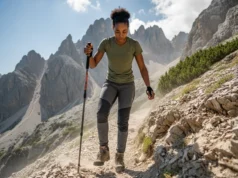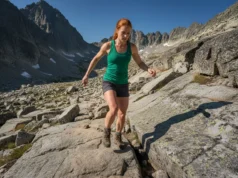In this article
Imagine you’re on a steep, gravelly descent where every foot placement matters. You feel the sharp edge of a rock under your arch, yet your foot remains stable, protected by a full-grain leather upper bonded to a polyurethane midsole and a Vibram rubber outsole whose multi-directional lugs bite into loose ground. That engineered conversation—mediated by Gore-Tex membranes, EVA cushioning, and torsional shanks—is the language of hiking boot anatomy this guide will teach you. We’ll deconstruct every part of a hiking boot so you can choose the right hiking gear for any trail or terrain.
The Hiker’s Foundation: From Ancient Necessity to Modern Engineering
How did a 5,300-year-old shoe influence modern boot design?
The earliest known technical footwear belonged to Ötzi the Iceman, a 5,300-year-old mountaineer whose shoe was a purpose-built survival tool. Constructed with a bearskin outsole, deerskin upper panels, and a cordage rand for structure, it solved the same timeless challenges we face today: durability against sharp terrain, traction pattern on unstable ground, and insulation against cold. Dry grass and fur created a micro-climate balancing breathability with waterproofing capability, proving that innovation in hiking footwear has always been driven by necessity.
From those rudimentary leather wraps, boot design evolved slowly until the post-WWI Montebelluna district birthed the modern industry. Three revolutions re-defined hiking boot components: Vibram’s rubber lug sole delivered unprecedented traction, Gore-Tex’s waterproof-breathable membrane solved the paradox of staying dry yet ventilated, and the adoption of EVA vs polyurethane midsoles introduced cushioning level and load-bearing stiffness without brutal break-ins. This arc—from absolute durability (heavy leather, painful break-in period) to a nuanced balance of weight, support level, and comfort—is key to appreciating today’s specialized boot categories. Ready to move from history to selection? Start with choosing the right type of hiking footwear.
The Upper: Your Boot’s Armor and Climate Control System
What are the key parts of a boot’s upper and what do they do?
Everything above the outsole is the upper, the first line of defense and comfort. The collar cushions the ankle while blocking debris; the tongue shields the instep from lace pressure and, when gusseted, becomes a waterproof barrier bridging tongue and upper. Inside, the lining wicks sweat to prevent blisters, while an integrated waterproof membrane—such as Gore-Tex—balances breathability with waterproofing capability. Lacing hardware—eyelets, D-rings, speed hooks—dictates how precisely you can tune fit and support level.
Structural reinforcements turn soft fabric into armor. The toe cap—often hidden beneath the upper—absorbs impact, while the heel counter locks the calcaneus in place to eliminate heel lift. A rubber rand wraps the lower edge like a bumper, shielding seams from abrasion on granite or scree. Two-zone lacing, anchored by a locking hook at the ankle, lets you cinch the quarter and vamp independently for a custom fit. These hiking boot components form an integrated system whose synergy determines overall performance. For a deeper dive into leather construction, see a deeper dive into men’s leather hiking boots.
What’s the real-world difference between leather and synthetic uppers?
Material choice is a deliberate trade-off among durability rating, weight, breathability, and break-in period. Full-grain leather remains the benchmark for rugged protection: it shrugs off abrasion, resists water when treated, and molds to your foot over hundreds of miles, making it the go-to for backpacking boots. Yet that same toughness translates into weight and a long break-in period. Nubuck leather, lightly sanded from the top grain, trades a sliver of durability for improved flexibility—ideal for rugged day hikes without the freight-train mass of full-grain.
Footwear Comparison for Hiking
A guide to help you choose the right footwear for your next outdoor adventure.
Pros
Lightweight, highly breathable, no break-in, comfortable.
Cons
Minimal support and protection, less durable.
Pros
Good balance of support and flexibility, versatile.
Cons
Heavier and less breathable than shoes.
Pros
Excellent support and stability, highly durable, protective.
Cons
Heavy, less breathable, requires break-in (leather models).
Pros
Maximum protection, warmth, and stability; crampon compatible.
Cons
Extremely heavy and rigid, unsuitable for general hiking.
Split-grain leather/synthetic hybrids combine leather armor in high-wear zones with nylon or polyester mesh for breathability and low weight, creating versatile hiking boots that feel comfortable right out of the box. Fully synthetic uppers, woven from synthetic fabrics, are ultralight champions: they dry fast, breathe exceptionally well, and eliminate break-in period, but surrender abrasion resistance the moment they meet sharp scree. Match upper materials to mission: full-grain for mountaineering boots, hybrids for day hiking, and synthetics for fast-and-light missions in hot climates. When waterproofing enters the conversation, the debate intensifies—are waterproof hiking shoes worth it? explores the breathability versus waterproofing capability paradox.
How can specific lacing techniques prevent blisters and pain?
Lacing is a dynamic fit tool that solves problems on the fly. The Surgeon’s Knot, created by wrapping the laces twice before pulling tight, forms a friction lock that refuses to slip; placed over the instep, it anchors the heel and eliminates micro-movements that spawn blisters. Window Lacing—also called Box Lacing—skips a crossover directly over a hot spot, creating a pressure-free window without loosening the rest of the hiking boot.
Pro-Tip: Bring your fully loaded backpack to the fitting session. Pack weight changes foot volume and arch height, so testing under realistic load reveals fit issues you’ll never feel while strolling around the carpeted showroom.
Descending steep grades slams toes into the toe box, but Toe-Relief Lacing—skipping the lowest eyelets—adds volume to prevent toe bang. At the ankle, the Runner’s Loop (a.k.a. Heel Lock) uses extra setback eyelets to crank the upper snugly around the ankle, locking the heel with mechanical advantage. Mastering these four techniques can transform an average hiking boot anatomy into a blister-free, high-performance tool. For the full story on skin integrity, see a complete guide to preventing blisters.
The Sole Unit: The Engine of Your Boot
Why is the midsole the most critical component for comfort and support?
Hidden between foot and outsole, the midsole is the unseen heart of support, dictating cushioning level, shock absorption, and torsional rigidity. Lightweight hiking shoes rely on EVA (ethylene-vinyl acetate)—a feather-light foam that cushions each step. The catch is longevity: EVA “packs out,” permanently compressing until it feels like cardboard. Polyurethane (PU) answers with density and resilience; it’s firmer yet more durable, making it the standard for backpacking boots and mountaineering boots that must maintain load-bearing stiffness under week-long pack weights.
| Characteristic | EVA (Ethylene Vinyl Acetate) | Polyurethane (PU) |
|---|---|---|
| Cushioning Feel | Soft, cushy, flexible | Firm, stable |
| Durability/Lifespan | Fair; compresses and “packs out” over time | Excellent; highly resistant to compression |
| Weight | Lighter | Heavier |
| Cost | Less expensive | More expensive |
| Flexibility | More flexible | Less flexible (stiffer) |
| Typical Boot Type | Trail running shoes, lightweight hiking shoes/boots | Backpacking boots, mountaineering boots |
Buried inside the midsole are two silent bodyguards: the shank and the plate. A steel shank or nylon insert runs beneath the arch to resist torsional twisting, preventing the boot from folding like a taco under heavy backpacks and reducing foot fatigue. Plates (or rock plates) are thin shields that stop sharp stones from bruising the plantar fascia. Contrary to popular belief, stiffness/flexibility is not the enemy of comfort; on rugged terrain, a stiff midsole behaves like a stable platform, conserving energy and sparing muscles from micro-adjustments. In long miles with big weight, stiffness equals comfort.
How do outsole lugs and rubber compounds provide traction?
The outsole is the rubber layer that meets the earth, and its lug design is a science of compromise. Soft, sticky rubber grips like a gecko on polished granite but erodes quickly, while hard rubber lasts thousands of miles yet can skate on slick roots. Lug depth follows the same logic: deep, aggressive lugs—5 mm or more—bite into mud and snow but feel clattery on hardpack, and widely spaced, self-cleaning lugs shed muck instead of clogging like a tractor tire. Multi-directional lugs ensure traction whether you’re powering uphill, braking on a descent, or side-hilling across loose scree.
The heel brake—a pronounced cluster of lugs on the heel—acts as a literal brake pad, catching your slide before momentum takes over. Up front, a climbing zone gives purchase on rock slabs when scrambling. Innovations like Vibram’s Traction Lug micro-features expand surface area for extra traction without adding weight. Ultimately, outsole design is a calculated match of rubber compound and lug pattern to terrain suitability, turning chaotic mountain surfaces into predictable partnerships.
Beyond the Parts: How Boot Design Impacts Your Hike
What is the truth about “ankle support” in hiking boots?
The industry has long marketed high collars as ankle saviors, but physics tells a different story. A padded fabric cuff cannot resist the violent inversion that causes a sprain; leverage is simply too great. Real ankle support comes from torsional rigidity, the sole’s resistance to twisting along its length. That rigidity is engineered through a stiff midsole, typically polyurethane, and an internal shank.
When you step on an off-camber rock, a flexible sole twists and transmits rotational force into the ankle joint. A torsionally rigid sole refuses to twist, creating a stable platform that prevents those forces from ever reaching the ankle. Grab a boot by heel and toe and try to wring it like a towel; a supportive boot fights back. While a high collar protects against scrapes, its contribution to actual support level is minimal compared to sole stiffness. For peer-reviewed data, see research into shaft stiffness and ankle joint biomechanics; for practical implications, explore the debate between trail runners and hiking shoes.
How can I ensure a perfect, blister-free fit?
No Gore-Tex membrane or space-age midsole can compensate for poor fit. Shop at day’s end when feet are swollen, wearing the exact socks you’ll use on the trail. Begin with length: pull the insole (or footbed) out and stand on it; you need a full thumb’s width—roughly half an inch—between your longest toe and the front edge to prevent toe bang on descents. Check width and volume: the quarter and vamp should cradle the midfoot snugly, yet allow toes to wiggle inside the toe box.
Pro-Tip: If you’re between half sizes, go up; you can fine-tune volume with thicker socks or aftermarket footbeds, but you can’t create length that isn’t there.
The Heel Lock Test is non-negotiable: lace firmly, walk an incline, and ensure your heel stays locked with minimal lift. Any slippage will spawn blisters. Finally, dispel the myth that boots must be broken in through pain. While heavy full-grain leather uppers still require a break-in period, most modern hiking boots feel comfortable in the store. For women, who often have narrower heels and unique volume profiles, our comprehensive guide to women’s hiking boots dives deeper into gender-specific fit strategies.
Conclusion
You now possess four non-negotiable truths: ankle support is generated by torsional rigidity, not collar height; material composition—from full-grain leather to synthetic fabrics—dictates durability, weight, and breathability trade-offs; stiffness/flexibility equals comfort on rugged terrain; and perfect fit is the ultimate arbiter of blister prevention. Armed with this hiking boot anatomy guide, you can decode any product wall and select the engineered solution that matches your mission, terrain suitability, and pack weight—whether that’s day hiking the Four Pass Loop or mountaineering in the Chicago Basin. The trail is waiting—go choose your tool with confidence.
Hiking Footwear Comparison
A guide to choosing the right boot for your adventure
Key Features & Terrain
Typical Terrain: Maintained trails, flat to rolling hills.
Upper: Synthetic mesh for maximum breathability.
Midsole/Stiffness: Flexible; EVA midsole; minimal or no shank.
Outsole: Shallow to medium lugs; flexible rubber.
Pros & Cons
Pros: Lightweight, highly breathable, no break-in, comfortable.
Cons: Minimal support and protection, less durable.
Key Features & Terrain
Typical Terrain: Varied trails, moderate hills, some uneven ground.
Upper: Split-grain leather/synthetic hybrid for balance.
Midsole/Stiffness: Moderately flexible; EVA or light PU midsole; half-length shank.
Outsole: Medium depth, multi-directional lugs; heel brake.
Pros & Cons
Pros: Good balance of support and flexibility, versatile.
Cons: Heavier and less breathable than shoes.
Key Features & Terrain
Typical Terrain: Rugged, uneven, and off-trail terrain.
Upper: Full-grain or Nubuck leather for durability; full rand.
Midsole/Stiffness: Stiff; PU midsole; full-length shank for rigidity.
Outsole: Deep, aggressive lugs; durable rubber; prominent heel brake.
Pros & Cons
Pros: Excellent support and stability, highly durable, protective.
Cons: Heavy, less breathable, requires break-in (leather models).
Key Features & Terrain
Typical Terrain: Technical rock, snow, and ice; high-alpine environments.
Upper: Insulated full-grain leather or rigid plastic shell.
Midsole/Stiffness: Very stiff to rigid; full-length steel or carbon fiber shank.
Outsole: Deep, sharp lugs; climbing zone; crampon-compatible.
Pros & Cons
Pros: Maximum protection, warmth, and stability; crampon compatible.
Cons: Extremely heavy and rigid, unsuitable for general hiking.
Frequently Asked Questions
What is the difference between a midsole and an outsole?
The outsole is the rubber layer that actually contacts the ground, featuring lugs for traction pattern and a heel brake for descents. The midsole—typically EVA (ethylene-vinyl acetate) or polyurethane—lies above it, responsible for cushioning level, shock absorption, and torsional rigidity.
Why do some boots have a rubber strip (rand) around the bottom?
A rubber rand acts as a protective bumper that shields the joint between upper and outsole from abrasion, cuts, and impacts on rocky or icy terrain, dramatically increasing the durability rating of hiking boots.
Do I really need waterproof (Gore-Tex) boots?
Waterproof boots with Gore-Tex membranes excel in cold, snowy, or consistently wet terrains, but they sacrifice breathability and can overheat feet in warm weather. For hot climates or routes with frequent river crossings, non-waterproof, quick-drying mesh hiking shoes are often healthier.
What is a “shank” in a hiking boot?
A shank—often steel shank, nylon, or aluminum—is a stiff insert sandwiched between midsole and outsole to add load-bearing stiffness and torsional rigidity. Its primary function is to reduce foot fatigue when carrying heavy pack weights by preventing unnatural flex under the arch.
Risk Disclaimer: Hiking, trekking, backpacking, and all related outdoor activities involve inherent risks which may result in serious injury, illness, or death. The information provided on The Hiking Tribe is for educational and informational purposes only. While we strive for accuracy, information on trails, gear, techniques, and safety is not a substitute for your own best judgment and thorough preparation. Trail conditions, weather, and other environmental factors change rapidly and may differ from what is described on this site. Always check with official sources like park services for the most current alerts and conditions. Never undertake a hike beyond your abilities and always be prepared for the unexpected. By using this website, you agree that you are solely responsible for your own safety. Any reliance you place on our content is strictly at your own risk, and you assume all liability for your actions and decisions in the outdoors. The Hiking Tribe and its authors will not be held liable for any injury, damage, or loss sustained in connection with the use of the information herein.
Affiliate Disclosure: We are a participant in the Amazon Services LLC Associates Program, an affiliate advertising program designed to provide a means for us to earn advertising fees by advertising and linking to Amazon.com. As an Amazon Associate, we earn from qualifying purchases. We also participate in other affiliate programs and may receive a commission on products purchased through our links, at no extra cost to you. Additional terms are found in the terms of service.





